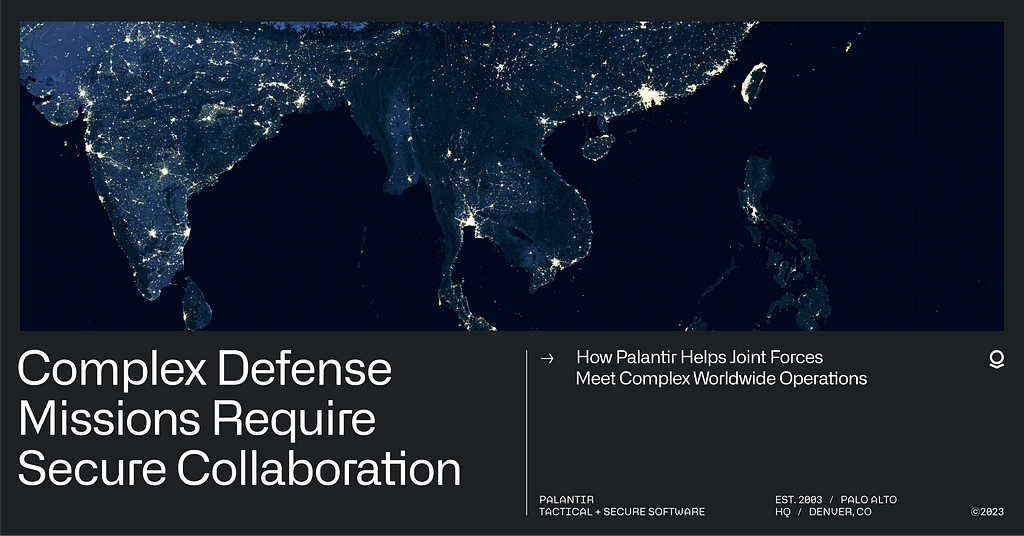How Palantir helps Joint Forces meet complex worldwide operations

U.S. Joint Forces face a complex range of worldwide operations — and don’t always do so alone. Emphasized in the 2022 National Security Strategy, “our alliances and partnerships around the world are our most important strategic asset and an indispensable element contributing to international peace and stability.” From NATO partners to alliances in the Indo-Pacific and traditional security partnerships, the U.S. and its allies are charged with bolstering deterrence in an increasingly confrontational world. These alliances and partnerships require an information environment that is secure and agile, facilitating real-time coordination and collaboration.
“Palantir was founded on the belief that the United States, its allies, and partners should harness the most advanced technical capabilities for their defense and prosperity.”
— Dr. Alex Karp, Palantir CEO
In this blog post, we explore how the Palantir platform is designed for secure information sharing in classified environments, including with allies and mission partners. Within the platform, U.S. and allies can accelerate collaboration to drive joint mission execution, enhancing and securing decision-making — from creating operational plans in real-time to synchronizing key documentation across classifications and geographies.
Forged in the Field
For nearly 20 years, Palantir has worked closely with the defense and intelligence communities, embedding software engineers and product developers to design and deliver technical solutions that connect data, analytics, and operations across mission enclaves and partner networks — even in disconnected environments.
Based on our first-hand understanding of the challenges faced sharing information in classified environments with allies and mission partners, we developed solutions that are helping advance a modern and connected data-centric force.
Uncompromising Security
The Palantir platform is built with data protection as the cornerstone, integrating previously stove-piped data sources and structuring mission data with a shared semantic layer that is security-aware. Our solution offers additional protections to the networks and authoritative data sources involved by leveraging a robust backend of federated access management and control across role, echelon, and environment — even in disconnected, intermittent, and/or low bandwidth (DIL) environments. We maintain rigorous, externally verified infrastructure and operations standards and are compliant with CNSSI 1253, ICD 503, and NIST SP 800–53 and accreditation at the IL2, IL5, IL6, and TS/SCI levels.
By fielding a data-centric environment powered by intelligent security, the U.S., allies, and communities of interest can leverage secure collaboration capabilities to seamlessly operate across security domains and mission enclave and enhance decision-making capabilities.
Features
When building the Secure Collaboration product suite, we prioritize features that match the needs of modern warfighters. Our platforms prioritize security to support collaboration across networks and toolsets.
Security
- Adaptable Multi-level Security. Collaborative and data-backed documents, slides, spreadsheets, and maps intelligently maintain underlying data’s security level, with the option of automatically redacting data where necessary, mapping to lower classification environments.
- Robust Classification and Security Permissions. Access Control Lists (ACLs) ensure users can only view the information they are authorized to access based on ICAM controls. Controls can be based on mission sensitivity, personnel roles, data protection regulations, and other security considerations.
Collaboration
- Share and Collaborate Across Distributed Networks. Make rapid operational decisions that are fully informed by a global dataset without jeopardizing data integrity or security.
- Real-Time Data Sharing without Duplication or Destruction. Live data from connected systems is woven together without creating duplicate or conflicting copies of the data, improving situational awareness and mitigating the threat of tampering.
Interoperability
- Interoperable architecture. Connect with source systems and collaboration tooling outside the platform. Push updates back to source systems and downstream applications.
- Designed to Handle Denied, Disconnected, Intermittent, or Limited (DDIL) Environments. Data is synchronized across disconnected systems, optimized even in low bandwidth conditions, and has the automatic ability to queue data transmitted and received when offline.
Capabilities
The Secure Collaboration suite is a set of interoperable tools that rely on the same ever evolving data asset. This ensures that users from intelligence to operations are all making decisions based on the latest contributions of their collaborators. Our tooling supports key work outputs — like presentations and reports, while also providing novel ways to share these products securely and interoperate on the underlying data.
Briefings. Enable collaborative slide development and live briefing with data-backed presentations. Users can drag and drop data and analysis from other applications to quickly build slides. For example, users embed dynamic maps into mission planning presentations, which then update as the underlying map evolves. Intelligent fields auto-populate where data already exists in the system and dynamically generate additional fields and options based on user input. The resulting presentations are both data and security-aware, enabling new forums for briefings and presentations, without compromising data security.
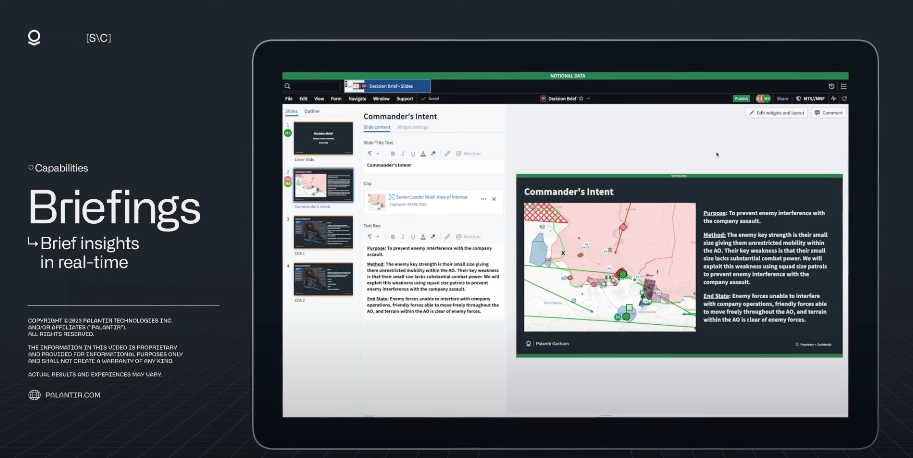
Chat. Users share direct messages, files, channels, and data in a classification-controlled, cross-network chat application, with automatic translation, data redaction, and mission data extraction. Palantir Chat interoperates with existing messaging systems, allowing users to collaborate live with users on other chat clients while operating within an interface that’s tightly integrated with their data and workflows. Multi-user channels use access controls and data redaction to ensure that data is only ever shared in channels that meet the required classification. Because the platform handles security requirements, users are empowered to collaborate across traditionally siloed teams, networks, and even countries, enabling 21st century collaboration while meeting the security expectations that our users expect.
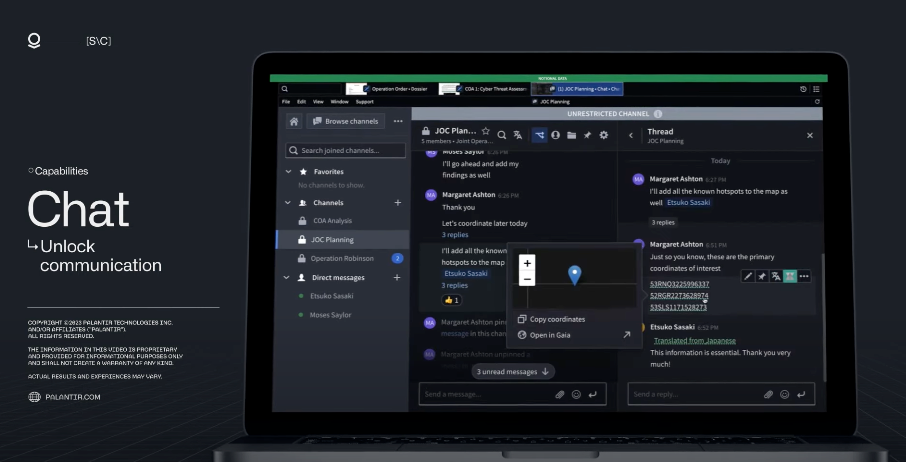
Dossier. Capture, contextualize, and share data-driven insights and intelligence products. Users can create collaborative data-backed documents that update in real time and follow defined business processes for document approval, dissemination, and archiving. Create new documents from scratch or via templates, and trace data back to the source with links that show provenance. Reports maintain their classification as they’re shared across contexts and networks, ensuring that data contained is only displayed to credentialed users in approved contexts.
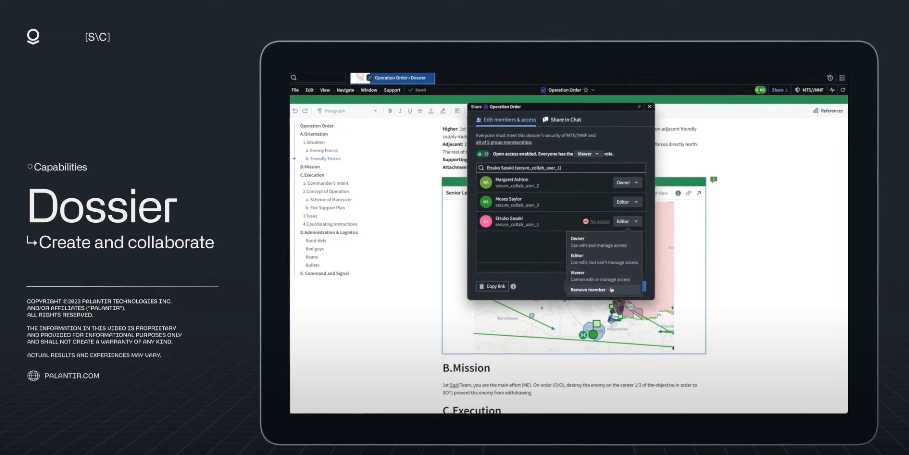
Gaia. Facilitate ops-intel integration of the battlefield with the Palantir platform’s geospatial command and control capability. Informed by our work with U.S. forces in Afghanistan, Palantir engineers designed Gaia to facilitate battlefield ops-intel integration via the Palantir platform’s geospatial command and control capability, Gaia acts as a single pane of glass to support otherwise siloed users, securely integrating partners into all phases of an operation, including intelligence preparation, digital mission planning, and live battle tracking. Users across mission enclaves and communities of interest can concurrently build a holistic operations plan with a shared understanding of both mission and operating environment, all contributing back to an integrated data asset.
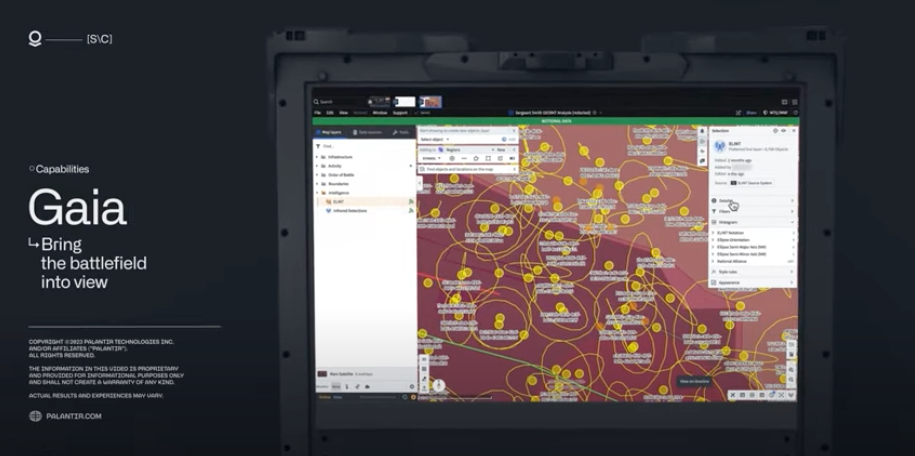
Inbox. Keep track of data updates and alerts all in one global message center. Inbox allows you to design custom queries that generate alerts and helps you keep track of an ever changing data landscape. Trigger custom alerts — and take necessary action — when new data is added to priority topics, when geofences are crossed, or when in-platform AI detects information relevant to your area of responsibility. Inbox centralizes alerts generated across data layers and workflows, enabling users to keep track of many moving parts at once.
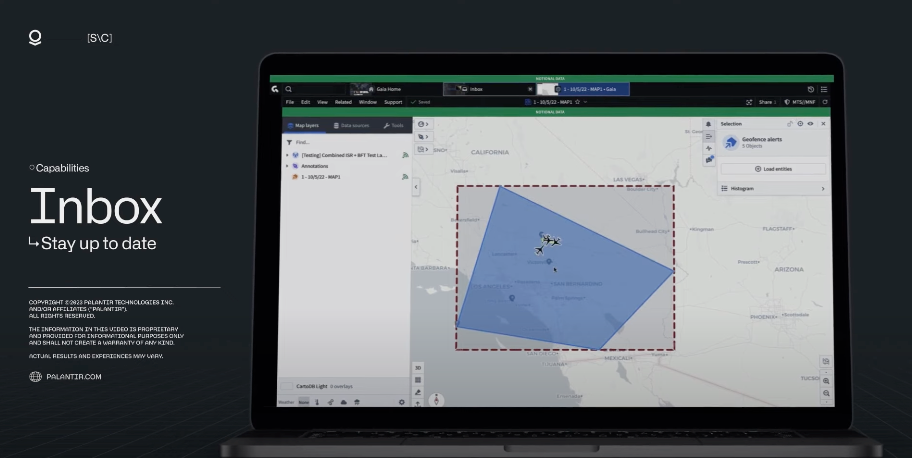
Video. Leverage AI-enabled video to power decisions. Video supports Augmented Reality overlays that display intelligence from canonical sources, live data streams, and map layers in real time. Georectification ensures that every pixel in every video frame is mapped to a real-world geocoordinate. By tagging entities in the observed area, such as buildings, cars, or persons of interest, users can layer their institution’s geospatial data onto live or archived video in real time. AI-derived detections are viewable in real time as Augmented Reality (AR) overlays, along with maps for searching and annotating. With automated insights from computer vision over full motion video, users can discover and decipher events as they evolve.
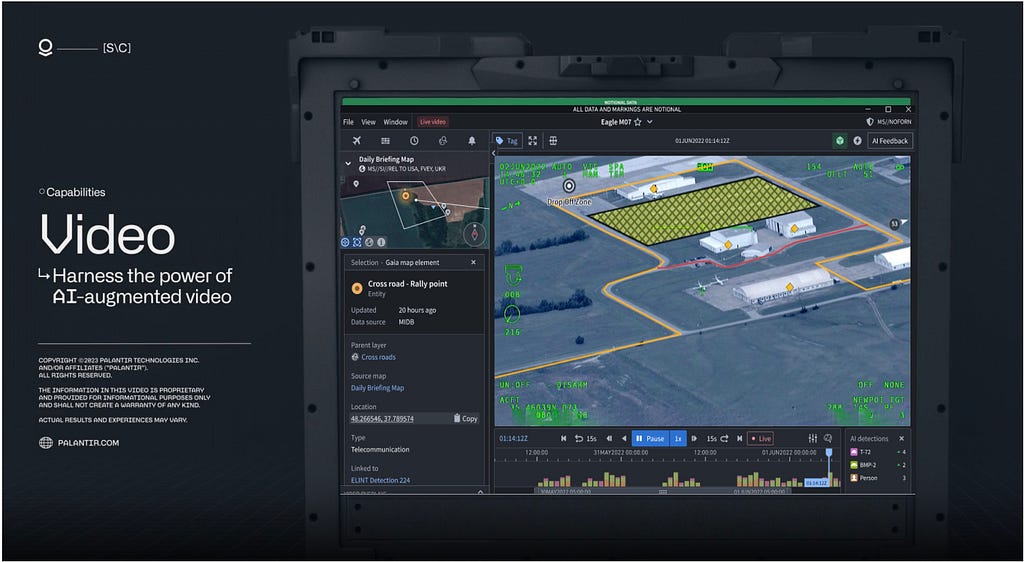
Secure Collaboration in Action
To illustrate how Palantir’s secure collaboration capabilities come together, let’s consider a notional example.
In this scenario, U.S. forces detect a massive cyber attack that’s been carried out by a suspected state actor. Defensive cyber teams and intelligence operators in the region are tasked to collect emerging evidence about the attack and compile their shared understanding in Dossier in real-time.
U.S. forces bring in allied partners from different nations to bolster the intelligence picture and improve situational understanding of efforts underway to detect and deter subsequent attacks. Thanks to Palantir’s advanced Chat system, these mission partners and U.S. forces can communicate securely and in real-time.
Forces can embed live updating Gaia maps in chat and in their Dossier collaboration, to monitor geospatial indicators of a potential kinetic second-wave attack.
Leveraging information seamlessly extracted from multiple data sources and shared securely, U.S. leaders and coalition partners can continuously track updates as the situation unfolds — and plan operations with a shared understanding of the threats posed, assets involved, and options for a response.
Conclusion
One of the strongest measures of deterrence available to the U.S. and our allies is the adoption of technology that helps reduce friction and speeds time to decision-making. That advantage is delivered through the integration of secure software capabilities.
With Palantir’s Secure Collaboration suite, U.S. forces and allies are better equipped to meet the complex mission needs of today — and tomorrow.
Learn more about Palantir Secure Collaboration.
Author
Gene Robinson, Product Manager, Palantir Technologies
Complex Defense Missions Require Secure Collaboration was originally published in Palantir Blog on Medium, where people are continuing the conversation by highlighting and responding to this story.
